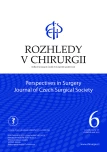Akromikoklavikulární luxace u zlomenin lopatky – pathoanatomie poranění
Authors:
T. Strnad; J. Bartonicek; M. Tucek
Authors‘ workplace:
Department of Orthopedics, 1st Faculty of Medicine, Charles University and the Central Military Hospital – University Military Hospital, Prague
Published in:
Rozhl. Chir., 2022, roč. 101, č. 6, s. 273-277.
Category:
Original articles
doi:
https://doi.org/10.33699/PIS.2022.101.6.272–276
Overview
Úvod: Poraněním AC kloubu u zlomenin lopatky se detailně dosud nikdo nezabýval. Cílem této studie je proto popsat pathoanatomii těchto poranění.
Metody: V souboru 519 zlomenin lopatky u dospělých pacientů vzniklém v období 2002−2020 jsme identifikovali celkem 20 (3,9 %) případů spojených s AC luxací. Jednalo se o 17 mužů a 3 ženy průměrného věku 49 roků (21−78). U všech pacientů byl proveden rtg snímek ramenního kloubu a následně CT vyšetření včetně 3D rekonstrukcí. Tato obrazová dokumentace umožnila hodnocení typu zlomeniny lopatky a typu poranění AC kloubu.
Výsledky: V 15 případech byla AC luxace spojena pouze s jednoduchou zlomeninou lopatky (7x zlomenina báze proc. coracoideus, 4x zlomenina akromia nebo laterální spiny, 2krát zlomenina těla lopatky, 1x zlomenina horního glenoidu a 1x zlomenina dolního glenoidu). V 5 případech se jednalo o vícečetné nebo komplexní zlomeniny lopatky (1x kombinace zlomeniny proc. coracoideus a laterální části spina scapulae, v 1 případě kombinace zlomeniny horního glenoidu a akromia, ve 2 případech komplexní intraartikulární zlomenina a v 1 případě skapulotorakální disociace).
Závěr: AC luxace je méně častým poraněním doprovázejícím zlomeniny lopatky. Nejčastěji se vyskytuje u zlomenin proc. coracoideus, akromia/ laterální spiny nebo horního glenoidu. Nebyla zaznamenána u zlomenin krčku lopatky.
Klíčová slova:
zlomenina – lopatka – akromikoklavikulární luxace – pathoanatomie
Sources
1. McGahan JP, Rab GT, Dublin A. Fractures of the scapula. J Trauma 1980;20(10):880−883. doi: 10.1097/00005373-198010000-00011.
2. Armstrong CP, Van der Spuy J. The fractured scapula: importance and management based on a series of 62 patients. Injury 1984;15(5):324−329. doi: 10.1016/0020-1383(84)90056-1.
3. Ada JR, Miller ME. Scapula fractures. Analysis of 113 cases. Clin Orthop Relat Res. 1991;269 : 174−180.
4. Gurtl E. Handbuch der Lehre von den Knochenbrüchen. Zweiter Teil. Hamm, Grote 1864 : 521−540.
5. Ehalt W. Luxatio acromioclavicularis mit gleichzeitigem Abriss des Processus coracoideus scapulae. Arch Orthop Trauma Surg. 1934;34 : 421−425. doi: 10.1007/ BF02580532.
6. Urist MR. Complete dislocation of the acromioclavicular joint; the nature of the traumatic lesion and effective methods of treatment with an analysis of forty-one cases. J Bone Joint Surg Am. 1946;28(4):813−837.
7. Allman FL. Fractures and ligamentous injuries of the clavicle and its articulation. J Bone Joint Surg Am 1967;49(4):774−784.
8. Lasda NA, Murray DG. Fracture separation of the coracoid process associated with acromioclavicular dislocation. Clin Orthop Relat Res. 1978;134 : 222−224.
9. Bernard TN Jr., Brunet ME, Haddad RJ Jr. Fractured coracoid process in acromioclavicular luxation. Report of four cases and review of the literature. Clin Orthop Relat Res. 1983;175 : 227−232.
10. Carr AJ, Broughton NS. Acromioclavicular dislocation associated with fracture of the coracoid process. J Trauma 1989;29(1):125−6. doi: 10.1097/00005373-198901000-00030.
11. Wilson KM, Colwill JC. Combined acromioclavicular dislocation with coracoclavicular ligament disruption and coracoid process fracture. Am J Sports Med. 1989;17(5):697−698. doi: 10.1177/036354658901700521.
12. Wang KC, Hsu KY, Shih CH. Coracoid process fracture combined with acromioclavicular dislocation and coracoclavicular ligament rupture. Clin Orthop Relat Res. 1994;300 : 112−122.
13. Kurdy NMG, Shah SV. Fracture of the acromion associated with acromioclavicular dislocation. Injury 1995;26(9):636−637. doi: 10.1016/0020-1383(95)00117-r.
14. DiPaola M, Marchetto P. Coracoid process fracture with acromioclavicular joint separation in an American football player: A case report and literature review. Am J Orthop. 2009;38(1):37−40.
15. Duan X, Zhang H, Zhang H, et al. Treatment of coracoid process fractures associated with acromioclavicular dislocation using clavicular hook plate. J Shoulder Elbow Surg 2010;19(2):e22−5. doi: 10.1016/j.jse.2009.09.004.
16. Bartoníček J, Frič V. Scapular body fractures: Results of the operative treatment. Int Orthop. 2011;35(5):747−53. doi: 10.1007/s00264-010-1072-y.
17. Cole PA, Gauger EM, Herrera DA, et al. Radiographic follow-up of 84 operatively treated scapula neck and body fractures. Injury 2012;43(3):327−333. doi: 10.1016/j. injury.2011.09.029.
18. Allagui M, Koubaa M, Aloui I, et al.Coracoid fracture combined with distal clavicle fracture without coracoclavicular ligament rupture: A case report. J Clin Orthop Trauma 2013;4(4):190−193. doi: 10.1016/j.jcot.2013.10.002.
19. Asci M, Gunes T, Bilgie E, et al. Concurrent AC joint dislocation, coracoclavicular ligament rupture and coracoid base fracture. Knee Surg Sports Traumatol Arthrosc. 2016;24(7):2206−2208. doi: 10.1007/s00167-015-3524-9.
20. Tatro JM. Gilbertson JA, Schroder LK, et al.Five to ten-year outcomes of operatively treated scapular fractures. J Bone Joint Surg Am 2018;100(10):871−878. doi: 10.2106/JBJS.17.00673.
21. Bartoníček J. Scapular fractures. In: Tornetta P, Ricci WM, Ostrum RF, et al. Rockwood and Green´s Fractures in Adults. 9th ed. Philadelphia, Wolters Kluwer 2020 : 976−1008.
22. Rockwood CA. Injuries to the acromioclavicular joint. In: Rockwood, Green DP. Fractures in adults. Vol 1. 2nd ed. Philadelphia, JB Lippincott 1984 : 860−910.
Labels
Surgery Orthopaedics Trauma surgeryArticle was published in
Perspectives in Surgery

2022 Issue 6
Most read in this issue
- Retroperitoneální fibróza – diagnostika a léčba
- Atraumatický akutní kompartment syndrom − kazuistika
- Defenzivní medicína a vliv hrozby soudních sporů na lékaře
- Bilaterálna versus unilaterálna implantácia totálnej náhrady kolenného kĺbu – porovnanie klinických a funkčných výsledkov v dvojročnom sledovaní
